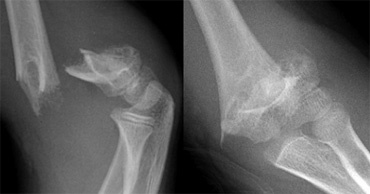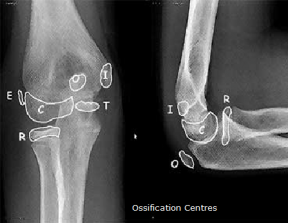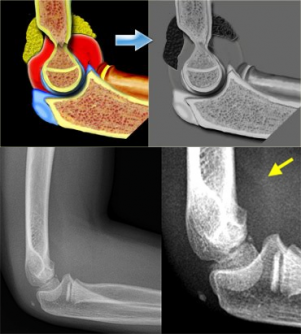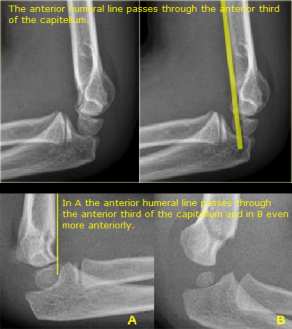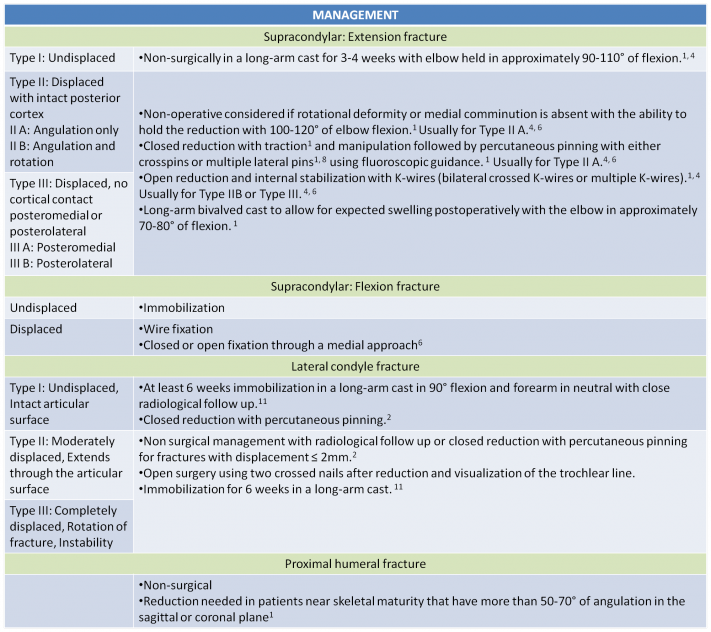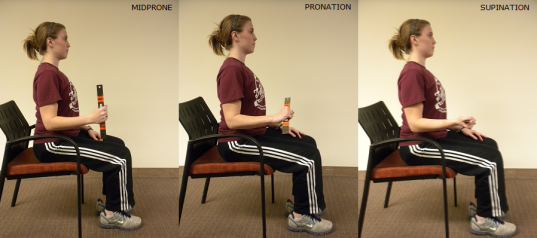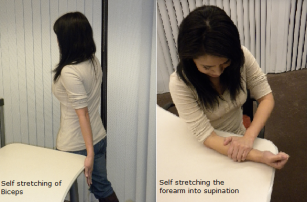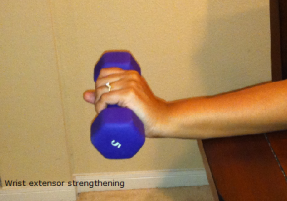Pediatric Humeral Fracture: Difference between revisions
No edit summary |
No edit summary |
||
| (86 intermediate revisions by 10 users not shown) | |||
| Line 1: | Line 1: | ||
<div class="editorbox"> | |||
'''Original Editors''' Ashley Bohanan, Alisha Lopez, Hannah Duncan, Neha Palsule, Brittany Buenteo | '''Original Editors''' Ashley Bohanan, Alisha Lopez, Hannah Duncan, Neha Palsule, Brittany Buenteo | ||
'''Lead Editors''' | '''Lead Editors''' | ||
</div> | </div> | ||
== Definition/Description == | == Definition/Description == | ||
Pediatric humeral fractures can occur in several locations including the proximal, shaft (diaphysis), or the distal humerus (supracondylar ridges, medial and lateral epicondyles). Of these, supracondylar fractures are the most common<ref name="Hart">Hart ES, Grottkau BE, Rebello GN, Albright MB. Broken Bones: | Pediatric humeral fractures can occur in several locations including the proximal humerus, shaft (diaphysis), or the distal humerus (supracondylar ridges, medial and lateral epicondyles). Of these, supracondylar fractures are the most common<ref name="Hart">Hart ES, Grottkau BE, Rebello GN, Albright MB. Broken Bones: Common Pediatric Upper Extremity Fractures – Part II. Orthopaedic Nursing. 2006;25(5):311-323.</ref> followed by lateral humeral condylar fractures.<ref name="Tejwani">Tejwani N, Phillips D, Goldstein RY. Management of Lateral Humeral Condylar Fracture in Children. Journal of the American Academy of Orthopaedic Surgeons. 2011;19:350-358.</ref> These fractures can result from a direct hit or a fall onto an outstretched hand (FOOSH).<ref name="Hart" /> In addition, these injuries occur predominantly in the younger population because their bodies are still in development.<ref name="Hart" /><strike><br></strike> | ||
< | <strike>[[Image:Supracondylar fractures.png|center]]</strike> | ||
(Photos Courtesy of The Radiology Assistant) | |||
== Epidemiology/Etiology == | == Epidemiology/Etiology == | ||
Upper extremity fractures are more common | Upper extremity fractures are more common than lower extremity fractures in children.<ref name="Hart" /> | ||
Proximal humeral fractures should be the first diagnosis considered in children between 9 and 15 years of age that sustained a shoulder injury.<ref name="Hart" /> Additionly, this fracture can occur in newborns due to a birth-related injury.<ref name="Hart" /> | |||
Humeral shaft | Humeral shaft fractures are uncommon in children. If this injury occurs without a major trauma, it should increase the suspicion for a possible non-accidental trauma (child abuse).<ref name="Hart" /> | ||
Lateral humeral condylar fractures account for 12-20% of all pediatric elbow fractures and occurs mostly in children about 6 years of age.<ref name="Tejwani" /> | Lateral humeral condylar fractures account for 12-20% of all pediatric elbow fractures and occurs mostly in children about 6 years of age.<ref name="Tejwani" /> | ||
| Line 32: | Line 25: | ||
Medial epicondyle fractures make up 11-20% of all injuries of the elbow in children with 30-55% of cases associated with a dislocation of the elbow.<ref name="Louahem">Louahem DM, Bourelle S, Buscayret F, Mazeau P, Kelly P, Dimeglio A, Cottalorda J. Displaced medial epicondyle fractures of the humerus: surgical treatment and results. A report of 139 cases. Archives of Orthopaedic and Trauma Surgery. 2010;130:649-655.</ref> | Medial epicondyle fractures make up 11-20% of all injuries of the elbow in children with 30-55% of cases associated with a dislocation of the elbow.<ref name="Louahem">Louahem DM, Bourelle S, Buscayret F, Mazeau P, Kelly P, Dimeglio A, Cottalorda J. Displaced medial epicondyle fractures of the humerus: surgical treatment and results. A report of 139 cases. Archives of Orthopaedic and Trauma Surgery. 2010;130:649-655.</ref> | ||
Supracondylar fractures comprise 65-75% of all elbow fractures in children.<ref name="Lord" /> These injuries are the most challenging and have the highest complication rate.<ref name="Hart" /> | |||
Supracondylar fractures mostly occur between the ages of 5 and 10<ref name="Ryan" /> with the peak incidence occurring between 5-8 years of age (after this, dislocations become more frequent).<ref name="Lord" /> | Supracondylar fractures mostly occur between the ages of 5 and 10<ref name="Ryan" /> with the peak incidence occurring between 5-8 years of age (after this, dislocations become more frequent).<ref name="Lord" /> This injury occurs during this time period due to greater likelihood of falls, general ligamentous laxity, weak bone structure at the supracondylar region,<ref name="Hart" /> and a joint position of hyperextension.<ref name="Marquis">Marquis CP, Cheung G, Dwyer JSM, Emery DFG. Supracondylar fractures of the humerus. Current Orthopaedics. 2008;22(1):62-69.</ref> Supracondylar fractures are more common in males and on the non-dominant side.<ref name="Lord" /> | ||
<br>'''Mechanism of injury:''' | |||
Proximal humeral fractures | Proximal humeral fractures | ||
*Fall or | *Fall or direct hit to the proximal humerus (most common)<ref name="Hart" /> | ||
Lateral humeral condyle fractures | Lateral humeral condyle fractures | ||
*A fall onto the hand while in elbow flexion or on the inner posterior part of a flexed elbow, or forceful adduction of the forearm<ref name="Tejwani" /> | *A fall onto the hand while in elbow flexion or on the inner posterior part of a flexed elbow, or forceful adduction of the forearm<ref name="Tejwani" /><br> | ||
Supracondylar fractures | Supracondylar fractures | ||
*Hyperextension occurs during a FOOSH with the elbow in extension, which indirectly puts force on the distal humerus and displaces it posteriorly; this can occur with or without a valgus or varus force. This ‘extension’ type of injury accounts for 95% of the cases.<ref name="Lord">Lord B, Sarraf KM. Paediatric supracondylar fractures of the humerus: | *Hyperextension occurs during a FOOSH with the elbow in extension, which indirectly puts force on the distal humerus and displaces it posteriorly; this can occur with or without a valgus or varus force. This ‘extension’ type of injury accounts for 95% of the cases.<ref name="Lord">Lord B, Sarraf KM. Paediatric supracondylar fractures of the humerus: acute assessment and management. British Journal of Hospital Medicine. 2011;72(1):M8-M11.</ref> | ||
*Children younger than 3 years usually incur this injury from falling from a height of less than 3 feet | *Children younger than 3 years usually incur this injury from falling from a height of less than 3 feet<ref name="Ryan">Ryan LM. Evaluation and management of supracondylar fractures in children. UpToDate. 2010:1-37.</ref> | ||
*Older children sustain fractures from falls from greater heights off of playground equipment | *Older children sustain fractures from falls from greater heights off of playground equipment<ref name="Ryan" /> | ||
*If the hand is in a supinated position, then a posterolateral displacement occurs.<ref name="Lord" /> | *If the hand is in a supinated position, then a posterolateral displacement occurs.<ref name="Lord" /> | ||
*If the hand is pronated, then a posteromedial displacement occurs (more common).<ref name="Lord" /> | *If the hand is pronated, then a posteromedial displacement occurs (more common).<ref name="Lord" /> | ||
*Direct trauma or a fall onto a flexed elbow seldom occurs resulting in a ‘flexion’ type injury (5%) with anterior displacement.<ref name="Lord" /><br> | *Direct trauma or a fall onto a flexed elbow seldom occurs resulting in a ‘flexion’ type injury (5%) with anterior displacement.<ref name="Lord" /> | ||
<br> | |||
''' Hyperextension Injury''' | |||
[[Image:Hyperextension Injury.png|center]] | |||
<br>''' Extreme Valgus'''<br> | |||
[[Image:Extreme Valgus.png|center|550x180px]]<br>(Photos Courtesy of The Radiology Assistant) | |||
== Characteristics/Clinical Presentation == | == Characteristics/Clinical Presentation == | ||
Appropriate age and mechanism of injury are highly suggestive factors when diagnosing a pediatric humeral fracture. Upon presentation, physicians should screen for neurovascular compromise and always be mindful of non-accidental injuries. | Appropriate age and mechanism of injury are highly suggestive factors when diagnosing a pediatric humeral fracture. Upon presentation, physicians should screen for neurovascular compromise and always be mindful of non-accidental injuries. | ||
'''Supracondylar fractures'''<br> | '''Supracondylar fractures'''<br> | ||
*Swollen, painful elbow with decreased range of motion | *Swollen, painful elbow with decreased range of motion | ||
*Gentle passive range of motion will be overtly painful | *Gentle passive range of motion will be overtly painful<ref name="Lord" /> | ||
*Child typically presents to the ER holding arm straight in pronation and refusing to flex the elbow secondary to pain. ( | *Child typically presents to the ER holding arm straight in pronation and refusing to flex the elbow secondary to pain.<ref name="Wu">Wu J, Perron A, Miller M, Powell S, Brady W. Orthopedic pitfalls in the ED: pediatric supracondylar humerus fractures. American Journal Of Emergency Medicine. October 2002;20(6):544-550. Available from: CINAHL Plus with Full Text, Ipswich, MA. Accessed November 27, 2011.</ref> | ||
<br>'''Lateral Condyle Fractures'''<br> | <br>'''Lateral Condyle Fractures'''<br> | ||
*Point tenderness over proximal humerus | *Point tenderness over proximal humerus | ||
*Pain with shoulder abduction and rotation | *Pain with shoulder abduction and rotation | ||
*Swelling and ecchymosis at the fracture site | *Swelling and ecchymosis at the fracture site<ref name="Hart" /> | ||
*S-Shaped Deformity | *S-Shaped Deformity | ||
*“Pucker” Sign | *“Pucker” Sign | ||
*Rotation Producing Angulation | *Rotation Producing Angulation<ref name="Marquis" /> | ||
== Differential Diagnosis == | == Differential Diagnosis == | ||
*'''Radial head subluxation or nursemaid’s elbow:''' Patient presentation is similar to supracondylar fracture. The history of traction mechanism with nursemaid’s elbow as opposed to a compression mechanism associated with fractures can help with the diagnosis. | *'''Radial head subluxation or nursemaid’s elbow:''' Patient presentation is similar to supracondylar fracture. The history of traction mechanism with nursemaid’s elbow as opposed to a compression mechanism associated with fractures can help with the diagnosis.<ref name="Wu" /> | ||
*'''Normal ossification centers''' at capitellum, radius, medial epicondyle, trochlea, olecranon and lateral epicondyle approximately appear at 1, 3, 5, 7, 9, and 11 years of age respectively. It is important to know this sequence to be able to distinguish a fracture from a normal finding. The ages may vary and ossification centers often appear earlier in | *'''Normal ossification centers''' at capitellum, radius, medial epicondyle, trochlea, olecranon and lateral epicondyle approximately appear at 1, 3, 5, 7, 9, and 11 years of age respectively. It is important to know this sequence to be able to distinguish a fracture from a normal finding. The ages may vary and ossification centers often appear earlier in females.<ref name="Hart" /> | ||
[[Image:Ossification centres.png|center|288x223px]] | |||
(Photos Courtesy of The Radiology Assistant) | |||
== Outcome Measures == | == Outcome Measures == | ||
Currently, there is no standard scale or functional measure used to assess the effectiveness of treatment in pediatric patients with a humeral fracture. Numeric pain rating scale (NPRS), girth measurements, and range of motion | Currently, there is no standard scale or functional measure used to assess the effectiveness of treatment in pediatric patients with a humeral fracture. Numeric pain rating scale (NPRS), girth measurements, and range of motion (ROM) measurements should be included in the examination and can be used as outcome measures. The Mayo Elbow Performance Scale (MEPS) is a commonly used physician-based elbow rating scale that has been utilized in studies investigating pediatric humeral fractures.<ref name="Fu">Fu D, Xiao B, Yang S, et al. Open reduction and bioabsorbable pin fixation for late presenting irreducible supracondylar humeral fracture in children. International Orthop (SICOT). 2011;35:725-730.</ref> | ||
| | ||
| Line 93: | Line 96: | ||
'''History:''' | '''History:''' | ||
It is essential to obtain a thorough explanation for the fracture in order to distinguish accidental from non-accidental injuries (pathological fractures, child abuse).The following questions should be addressed: | It is essential to obtain a thorough explanation for the fracture in order to distinguish accidental from non-accidental injuries (pathological fractures, child abuse).The following questions should be addressed:<ref name="Kraus">Kraus R, Wessel L. The Treatment of Upper Limb Fractures in Children and Adolescents. Dtsch Arztebl. 2010; 107(51-52): 903-910.</ref><ref name="Lord" /> | ||
*When did the injury occur? | *When did the injury occur? | ||
*Does the history involve a fall from a height | *Does the history involve a fall from a height | ||
*Is it a flexion or extension injury? | *Is it a flexion or extension injury? | ||
*Was the hand supinated or pronated? | *Was the hand supinated or pronated? | ||
| Line 102: | Line 105: | ||
*Any previous injury or surgery to either upper limb? | *Any previous injury or surgery to either upper limb? | ||
Common signs | Common signs of child abuse: | ||
*Inconsistent/contradictory accounts of the incident | |||
*Delayed presentation | |||
*Mechanism not consistent with findings | |||
*Fractures of different ages | |||
*If child abuse is suspected, a referral to the appropriate health care provider is warranted.<ref name="Kraus" /> | |||
'''Observation:''' | |||
*Localized swelling, ecchymosis, deformity, and other skin changes at the fracture site.<ref name="Hart" /><ref name="Lord" /> | |||
*Signs and symptoms of compartment syndrome such as intense pain upon mild extension or stretching of the fingers, paresthesia/numbness, diminished pulses, and pallor. –Medical Emergency<ref name="Hart" /> | |||
*Localized swelling, ecchymosis, deformity, and other skin changes at the fracture site. | |||
*Signs and symptoms of compartment syndrome such as intense pain upon mild extension or stretching of the fingers, paresthesia/numbness, diminished pulses, and pallor. –Medical Emergency | |||
'''Palpation:''' | '''Palpation:''' | ||
| Line 118: | Line 123: | ||
*Lateral supracondylar humeral fractures tend to present with greater deformity than lateral humeral condylar fractures. | *Lateral supracondylar humeral fractures tend to present with greater deformity than lateral humeral condylar fractures. | ||
'''Neurological | '''Neurological Exam:'''''<strike><br></strike>'' | ||
*Assess radial nerve injury with wrist extension and sensation in the dorsal aspect of the first webspace. | |||
*Assess median nerve injury with the patient’s ability to make the "ok sign" and sensation over the palmar tip of the index finger (autonomous area of the median nerve) | |||
*Assess ulnar nerve injury with strength testing of intrinsic muscles of the hand and sensation over the palmar tip of the little finger.<ref name="Lord" /> | |||
'''Assessment of joints above and below injury:''' | |||
*Range of motion in all planes | |||
*Strength'''''<strike><br></strike>''''' | |||
''' | |||
'''Special tests:''' | '''Special tests:''' | ||
| Line 139: | Line 141: | ||
'''Circulatory/Vascular:''' | '''Circulatory/Vascular:''' | ||
*Allen’s test: To assess radial and ulnar artery compromise due to close proximity to the epicondyles. | *Allen’s test: To assess radial and ulnar artery compromise due to close proximity to the epicondyles.<ref name="Hart" /> | ||
*If posterolateral displacement of the humerus, be highly suspicious of brachial artery. | *If posterolateral displacement of the humerus, be highly suspicious of brachial artery injury.<ref name="Lord" /> | ||
*White/pale and/or cool extremities indicate arterial compromise | *White/pale and/or cool extremities indicate arterial compromise, which requires immediate referral to the emergency department.<ref name="Hart" /> | ||
Examination procedures should be performed with caution as the child will experience intense pain and fear during the exam. Reassurance and comfort to the patient and their parent/guardian is important. | Examination procedures should be performed with caution as the child will experience intense pain and fear during the exam. Reassurance and comfort to the patient and their parent/guardian is important.<ref name="Hart" /><br> | ||
== Medical Management | == Medical Management == | ||
<u>'''Radiography'''</u><br> | <u>'''Radiography'''</u><br> | ||
Interpreting radiographs of pediatric humeral fractures is often challenging due to changing epiphyses during childhood | Interpreting radiographs of pediatric humeral fractures is often challenging due to changing epiphyses during childhood<ref name="Lord" /> and a child’s cooperation. Standard imaging includes: anteroposterior view with the elbow extended, lateral view with the elbow flexed to 90° and forearm in neutral, oblique views, and images of joints above and below.<ref name="Marquis" /> | ||
'''Normal Findings:'''<br> | |||
'''Anteroposterior View'''<br> | '''Anteroposterior View'''<br> | ||
*Baumann’s Angle- Angle formed between | *Baumann’s Angle - Angle formed between physeal line and long axis of the humerus. Average = 72°.<ref name="Marquis" /> | ||
*Olecranon | *Olecranon and medial and lateral epicondyles should maintain an equilateral triangular relationship.<ref name="Lord" /> | ||
'''Lateral View'''<br> | '''Lateral View'''<br> | ||
*Tear Drop- Visible in distal humerus | *Tear Drop - Visible in distal humerus, consists of the anterior line representing the posterior margin of the coronoid fossa and the posterior line representing the anterior margin of the olecranon fossa. Inferior portion is the ossification center of the capitellum. | ||
*Shaft-Condylar Angle-Angulation of the long axis of the humerus and the lateral condyle. Normal= 40°. | *Shaft-Condylar Angle - Angulation of the long axis of the humerus and the lateral condyle. Normal = 40°. | ||
*Anterior Humeral Line- Line | *Anterior Humeral Line - Line drawn through the anterior border of distal humeral shaft and passes through middle-third of the ossification center of the capitellum. | ||
'''Abnormal Findings:'''<br> | '''Abnormal Findings:'''<br> | ||
*Fat pad displacement- | *Fat pad displacement - Displacement of any of the three fat pads may indicate an occult fracture. Displacement of the posterior (olecranon) pad is almost always associated with a fracture; whereas, displacement of the anterior (coronoid) alone can occur without a fracture. | ||
*Posterior displacement of the ossification | *Posterior displacement of the ossification center of the capitellum in relation to the anterior humeral line is of value in minimal hyperextension of the distal fragment.<ref name="Marquis" /> | ||
''' ''' | |||
[[Image:Fat sign.png|left|301x334px|Fat pad displacement]] | |||
'''Anterior Humeral Line'''<br> | |||
[[Image:Anterior humeral line abnormal.png|right|292x329px]]<br> | |||
<br> | |||
<br> | |||
<br> | <br> | ||
<br> | |||
<br> | |||
<br> | |||
*'''Vascular insufficiency:''' Seen with | <br> | ||
*'''Forearm compartment syndrome | |||
*'''Nerve injury:''' Neurological injury can result from traction injury or attempted reduction and stabilization. | <br> | ||
*'''Cubitus varus deformity: '''Angular deformity or "gunstock" deformity is a long term complication and is mainly cosmetic.Modern surgical techniques have decreased its occurrence | |||
*'''Myositis ossificans''' is a rare complication seen after vigorous manipulation | <br> | ||
<br> | |||
'''<u></u>''' | |||
<br> | |||
'''Fat pad displacement''' | |||
(Photos Courtesy of The Radiology Assistant)<br> | |||
<br> | |||
'''<u>Management</u><br>''' | |||
Gartland’s 1959 classification<ref name="Hart" /><ref name="Wu" /><ref name="Marquis" /> and its subsequent modification by Wilkins<ref name="Marquis" /> are the most widely used classification systems. These classifications guide the standard of care for treatment for supracondylar fractures.<ref name="Hart" /><ref name="Fu" /><ref name="Mallo">Mallo G, Stanat S, Gaffney J. Use of the Gartland classification system for treatment of pediatric supracondylar humerus fractures. Orthopedics. 2010;33(1):19. Available from: CINAHL Plus with Full Text, Ipswich, MA. Accessed November 27, 2011.</ref> Additional factors such as radiographic displacement, mechanism of injury, and soft tissue status are considered to determine the most appropriate treatment.<ref name="Mallo" /> | |||
[[Image:Management of humeral fractures.png|714x632px]]<br> | |||
<br> | |||
<u>'''Complications'''</u> | |||
<br>'''Lateral humeral condyle fracture'''<br> | |||
*Secondary displacement, nonunion, malunion and tardy ulnar nerve palsy.<ref name="Marcheix">Marcheix PS, Vacquerie V, Longis B, Peyrou P, Fourcade L, Moulies D. Distal humerus lateral condyle fracture in children: When is the conservative treatment a valid option? Orthopaedics and Traumatology: Surgery and Research. 2011;97:304-307.</ref><ref name="Tejwani" /> | |||
'''Supracondylar fracture'''<br> | |||
*'''Vascular insufficiency:''' Seen with Type II and Type III fractures. Emergent vascular exploration surgery is indicated in patients without improvement after orthopedic care, especially if perfusion is compromised or if the patient complains of intractable pain suggestive of ischemia. Delayed release of brachial artery obstruction can lead to ischemic contractions of hand and/or forearm muscles or nerve injury.<ref name="Ryan" /> | |||
*'''Forearm compartment syndrome:''' The extensive swelling has the potential to cause permanent neurovascular damage.<ref name="Hart" /> Ischemia and infarction if left untreated may progress to development of '''[[Volkmann's_Contracture|Volkmann's ischemic contracture]]'''.<ref name="Ryan" /> | |||
*'''Nerve injury:''' Neurological injury can result from traction injury or attempted reduction and stabilization.<ref name="Lord" /> Most deficits are transient neuropraxias<ref name="Ryan" /><ref name="Hart" /><ref name="Lord" /> which resolve within 2 to 3 months. If they persist, surgical exploration<ref name="Ryan" /><ref name="Hart" /> or neurolysis<ref name="Hart" /> is considered. | |||
*'''Cubitus varus deformity:''' Angular deformity or "gunstock" deformity is a long term complication and is mainly cosmetic. Modern surgical techniques have decreased its occurrence<ref name="Hart" /><ref name="Ryan" /> from 58% to 3%.<ref name="Ryan" /> Surgical correction for cosmesis or mechanical symptoms<ref name="Marquis" /> should be delayed until the child has reached or is near skeletal maturity.<ref name="Hart" /> | |||
*'''Myositis ossificans''' is a rare complication seen after vigorous manipulation.<ref name="Lord" /> | |||
<br> | |||
<br> | <br> | ||
== Physical Therapy Management | == Physical Therapy Management == | ||
The indications for physical therapy after supracondylar humeral fractures in children are not clear in the literature, even in the presence of an active or passive limitation of elbow joint motion. | The indications for physical therapy after supracondylar humeral fractures in children are not clear in the literature, even in the presence of an active or passive limitation of elbow joint motion.<ref name="Keppler">Keppler P, Salem K, Schwarting B, et al. The Effectiveness of Physiotherapy After Operative Treatment of Supracondylar Humeral Fractures in Children. J Pediatr Orthop. 2005;25(3):314-316.</ref> Much of the controversy is partly due to an initial recovery in elbow motion with progressive improvements for up to a year regardless of physical therapy.<ref name="Keppler" /><ref name="Bernthal">Bernthal NM, Hoshino CM, Dichter D, et al. Recovery of Elbow Motion Following Pediatric Lateral Condylar Fractures of the Humerus. J Bone Joint Surg Am. 2011;93: 871-877.</ref> Physical therapy is not unsuccessful or totally contraindicated. Children who received physical therapy achieved a more rapid return of normal or near normal elbow range of motion.<ref name="Keppler" /> The primary goals of treatment should focus on pain reduction, healing, rapid recovery of mobility, and avoidance of late complications.<ref name="Kraus" /> At two weeks post proximal humeral fracture gentle pendulum and passive ROM exercises should be implemented.<ref name="Hart" /> For supracondylar and humeral shaft fractures after the cast is removed, passive and active motion, soft tissue stretching techniques, and strengthening exercises should be implemented to maximize functional outcome.<ref name="Hart" /><ref name="Keppler" /><ref name="Lord" /> Moreover, patient education should focus on instructing parents on how to monitor the child’s neurovascular status, recognize signs of compartment syndrome, and skin care around the cast.<ref name="Hart" /> Recovery is slower in children who are older, immobilized longer, and have a more severe injury.<ref name="Bernthal" /> | ||
[[Image:PRONATION-SUP.png|center|537x238px]] | |||
<br> | |||
[[Image:Biceps stretch.png|left|307x202px]][[Image:Wrist extensor str.png|center|287x202px]] | |||
== Key Research == | |||
*Lord B, Sarraf KM. Paediatric supracondylar fractures of the humerus: acute assessment and management. British Journal of Hospital Medicine. 2011;72(1):M8-M11. | |||
*Hart ES, Grottkau BE, Rebello GN, Albright MB. Broken Bones: Common Pediatric Upper Extremity Fractures – Part II. Orthopaedic Nursing. 2006;25(5):311-323.<br> | |||
== Resources == | |||
http://lib.sh.lsuhsc.edu/portals/orthopaedic/humeralfractures.pdf | |||
== Clinical Bottom Line == | |||
<br>Supracondylar humeral fractures are common in the pediatric population. The child’s age, ossification periods, and mechanism of injury are important to consider. Examining the patient’s neurovascular status is imperative and should be monitored throughout the course of treatment. Stiffness and limited range of motion are common impairments that should be addressed in physical therapy. There is limited evidence for physical therapy treatment and therefore clinicians should implement an impairment based approach. | |||
<references /> | == References == | ||
<references /> | |||
[[Category:Texas_State_University_EBP_Project]] | [[Category:Texas_State_University_EBP_Project]] | ||
[[Category:Primary Contact]] | |||
[[Category:Paediatrics]] | |||
[[Category:Paediatrics - Conditions]] | |||
[[Category:Fractures]] | |||
Latest revision as of 11:46, 4 June 2020
Original Editors Ashley Bohanan, Alisha Lopez, Hannah Duncan, Neha Palsule, Brittany Buenteo
Lead Editors
Definition/Description[edit | edit source]
Pediatric humeral fractures can occur in several locations including the proximal humerus, shaft (diaphysis), or the distal humerus (supracondylar ridges, medial and lateral epicondyles). Of these, supracondylar fractures are the most common[1] followed by lateral humeral condylar fractures.[2] These fractures can result from a direct hit or a fall onto an outstretched hand (FOOSH).[1] In addition, these injuries occur predominantly in the younger population because their bodies are still in development.[1]
(Photos Courtesy of The Radiology Assistant)
Epidemiology/Etiology[edit | edit source]
Upper extremity fractures are more common than lower extremity fractures in children.[1]
Proximal humeral fractures should be the first diagnosis considered in children between 9 and 15 years of age that sustained a shoulder injury.[1] Additionly, this fracture can occur in newborns due to a birth-related injury.[1]
Humeral shaft fractures are uncommon in children. If this injury occurs without a major trauma, it should increase the suspicion for a possible non-accidental trauma (child abuse).[1]
Lateral humeral condylar fractures account for 12-20% of all pediatric elbow fractures and occurs mostly in children about 6 years of age.[2]
Medial epicondyle fractures make up 11-20% of all injuries of the elbow in children with 30-55% of cases associated with a dislocation of the elbow.[3]
Supracondylar fractures comprise 65-75% of all elbow fractures in children.[4] These injuries are the most challenging and have the highest complication rate.[1]
Supracondylar fractures mostly occur between the ages of 5 and 10[5] with the peak incidence occurring between 5-8 years of age (after this, dislocations become more frequent).[4] This injury occurs during this time period due to greater likelihood of falls, general ligamentous laxity, weak bone structure at the supracondylar region,[1] and a joint position of hyperextension.[6] Supracondylar fractures are more common in males and on the non-dominant side.[4]
Mechanism of injury:
Proximal humeral fractures
- Fall or direct hit to the proximal humerus (most common)[1]
Lateral humeral condyle fractures
- A fall onto the hand while in elbow flexion or on the inner posterior part of a flexed elbow, or forceful adduction of the forearm[2]
Supracondylar fractures
- Hyperextension occurs during a FOOSH with the elbow in extension, which indirectly puts force on the distal humerus and displaces it posteriorly; this can occur with or without a valgus or varus force. This ‘extension’ type of injury accounts for 95% of the cases.[4]
- Children younger than 3 years usually incur this injury from falling from a height of less than 3 feet[5]
- Older children sustain fractures from falls from greater heights off of playground equipment[5]
- If the hand is in a supinated position, then a posterolateral displacement occurs.[4]
- If the hand is pronated, then a posteromedial displacement occurs (more common).[4]
- Direct trauma or a fall onto a flexed elbow seldom occurs resulting in a ‘flexion’ type injury (5%) with anterior displacement.[4]
Hyperextension Injury
Extreme Valgus
(Photos Courtesy of The Radiology Assistant)
Characteristics/Clinical Presentation[edit | edit source]
Appropriate age and mechanism of injury are highly suggestive factors when diagnosing a pediatric humeral fracture. Upon presentation, physicians should screen for neurovascular compromise and always be mindful of non-accidental injuries.
Supracondylar fractures
- Swollen, painful elbow with decreased range of motion
- Gentle passive range of motion will be overtly painful[4]
- Child typically presents to the ER holding arm straight in pronation and refusing to flex the elbow secondary to pain.[7]
Lateral Condyle Fractures
- Point tenderness over proximal humerus
- Pain with shoulder abduction and rotation
- Swelling and ecchymosis at the fracture site[1]
- S-Shaped Deformity
- “Pucker” Sign
- Rotation Producing Angulation[6]
Differential Diagnosis[edit | edit source]
- Radial head subluxation or nursemaid’s elbow: Patient presentation is similar to supracondylar fracture. The history of traction mechanism with nursemaid’s elbow as opposed to a compression mechanism associated with fractures can help with the diagnosis.[7]
- Normal ossification centers at capitellum, radius, medial epicondyle, trochlea, olecranon and lateral epicondyle approximately appear at 1, 3, 5, 7, 9, and 11 years of age respectively. It is important to know this sequence to be able to distinguish a fracture from a normal finding. The ages may vary and ossification centers often appear earlier in females.[1]
(Photos Courtesy of The Radiology Assistant)
Outcome Measures[edit | edit source]
Currently, there is no standard scale or functional measure used to assess the effectiveness of treatment in pediatric patients with a humeral fracture. Numeric pain rating scale (NPRS), girth measurements, and range of motion (ROM) measurements should be included in the examination and can be used as outcome measures. The Mayo Elbow Performance Scale (MEPS) is a commonly used physician-based elbow rating scale that has been utilized in studies investigating pediatric humeral fractures.[8]
Examination[edit | edit source]
History:
It is essential to obtain a thorough explanation for the fracture in order to distinguish accidental from non-accidental injuries (pathological fractures, child abuse).The following questions should be addressed:[9][4]
- When did the injury occur?
- Does the history involve a fall from a height
- Is it a flexion or extension injury?
- Was the hand supinated or pronated?
- What is the child’s hand dominance?
- Any previous injury or surgery to either upper limb?
Common signs of child abuse:
- Inconsistent/contradictory accounts of the incident
- Delayed presentation
- Mechanism not consistent with findings
- Fractures of different ages
- If child abuse is suspected, a referral to the appropriate health care provider is warranted.[9]
Observation:
- Localized swelling, ecchymosis, deformity, and other skin changes at the fracture site.[1][4]
- Signs and symptoms of compartment syndrome such as intense pain upon mild extension or stretching of the fingers, paresthesia/numbness, diminished pulses, and pallor. –Medical Emergency[1]
Palpation:
- Isolated point tenderness over area of humerus that was fractured.
- Lateral supracondylar humeral fractures tend to present with greater deformity than lateral humeral condylar fractures.
Neurological Exam:
- Assess radial nerve injury with wrist extension and sensation in the dorsal aspect of the first webspace.
- Assess median nerve injury with the patient’s ability to make the "ok sign" and sensation over the palmar tip of the index finger (autonomous area of the median nerve)
- Assess ulnar nerve injury with strength testing of intrinsic muscles of the hand and sensation over the palmar tip of the little finger.[4]
Assessment of joints above and below injury:
- Range of motion in all planes
- Strength
Special tests:
- Elbow extension test (Sensitivity: 96.8%, Specificity: 45.8%)
- Girth measurements
Circulatory/Vascular:
- Allen’s test: To assess radial and ulnar artery compromise due to close proximity to the epicondyles.[1]
- If posterolateral displacement of the humerus, be highly suspicious of brachial artery injury.[4]
- White/pale and/or cool extremities indicate arterial compromise, which requires immediate referral to the emergency department.[1]
Examination procedures should be performed with caution as the child will experience intense pain and fear during the exam. Reassurance and comfort to the patient and their parent/guardian is important.[1]
Medical Management[edit | edit source]
Radiography
Interpreting radiographs of pediatric humeral fractures is often challenging due to changing epiphyses during childhood[4] and a child’s cooperation. Standard imaging includes: anteroposterior view with the elbow extended, lateral view with the elbow flexed to 90° and forearm in neutral, oblique views, and images of joints above and below.[6]
Normal Findings:
Anteroposterior View
- Baumann’s Angle - Angle formed between physeal line and long axis of the humerus. Average = 72°.[6]
- Olecranon and medial and lateral epicondyles should maintain an equilateral triangular relationship.[4]
Lateral View
- Tear Drop - Visible in distal humerus, consists of the anterior line representing the posterior margin of the coronoid fossa and the posterior line representing the anterior margin of the olecranon fossa. Inferior portion is the ossification center of the capitellum.
- Shaft-Condylar Angle - Angulation of the long axis of the humerus and the lateral condyle. Normal = 40°.
- Anterior Humeral Line - Line drawn through the anterior border of distal humeral shaft and passes through middle-third of the ossification center of the capitellum.
Abnormal Findings:
- Fat pad displacement - Displacement of any of the three fat pads may indicate an occult fracture. Displacement of the posterior (olecranon) pad is almost always associated with a fracture; whereas, displacement of the anterior (coronoid) alone can occur without a fracture.
- Posterior displacement of the ossification center of the capitellum in relation to the anterior humeral line is of value in minimal hyperextension of the distal fragment.[6]
Anterior Humeral Line
Fat pad displacement
(Photos Courtesy of The Radiology Assistant)
Management
Gartland’s 1959 classification[1][7][6] and its subsequent modification by Wilkins[6] are the most widely used classification systems. These classifications guide the standard of care for treatment for supracondylar fractures.[1][8][10] Additional factors such as radiographic displacement, mechanism of injury, and soft tissue status are considered to determine the most appropriate treatment.[10]
Complications
Lateral humeral condyle fracture
Supracondylar fracture
- Vascular insufficiency: Seen with Type II and Type III fractures. Emergent vascular exploration surgery is indicated in patients without improvement after orthopedic care, especially if perfusion is compromised or if the patient complains of intractable pain suggestive of ischemia. Delayed release of brachial artery obstruction can lead to ischemic contractions of hand and/or forearm muscles or nerve injury.[5]
- Forearm compartment syndrome: The extensive swelling has the potential to cause permanent neurovascular damage.[1] Ischemia and infarction if left untreated may progress to development of Volkmann's ischemic contracture.[5]
- Nerve injury: Neurological injury can result from traction injury or attempted reduction and stabilization.[4] Most deficits are transient neuropraxias[5][1][4] which resolve within 2 to 3 months. If they persist, surgical exploration[5][1] or neurolysis[1] is considered.
- Cubitus varus deformity: Angular deformity or "gunstock" deformity is a long term complication and is mainly cosmetic. Modern surgical techniques have decreased its occurrence[1][5] from 58% to 3%.[5] Surgical correction for cosmesis or mechanical symptoms[6] should be delayed until the child has reached or is near skeletal maturity.[1]
- Myositis ossificans is a rare complication seen after vigorous manipulation.[4]
Physical Therapy Management[edit | edit source]
The indications for physical therapy after supracondylar humeral fractures in children are not clear in the literature, even in the presence of an active or passive limitation of elbow joint motion.[12] Much of the controversy is partly due to an initial recovery in elbow motion with progressive improvements for up to a year regardless of physical therapy.[12][13] Physical therapy is not unsuccessful or totally contraindicated. Children who received physical therapy achieved a more rapid return of normal or near normal elbow range of motion.[12] The primary goals of treatment should focus on pain reduction, healing, rapid recovery of mobility, and avoidance of late complications.[9] At two weeks post proximal humeral fracture gentle pendulum and passive ROM exercises should be implemented.[1] For supracondylar and humeral shaft fractures after the cast is removed, passive and active motion, soft tissue stretching techniques, and strengthening exercises should be implemented to maximize functional outcome.[1][12][4] Moreover, patient education should focus on instructing parents on how to monitor the child’s neurovascular status, recognize signs of compartment syndrome, and skin care around the cast.[1] Recovery is slower in children who are older, immobilized longer, and have a more severe injury.[13]
Key Research[edit | edit source]
- Lord B, Sarraf KM. Paediatric supracondylar fractures of the humerus: acute assessment and management. British Journal of Hospital Medicine. 2011;72(1):M8-M11.
- Hart ES, Grottkau BE, Rebello GN, Albright MB. Broken Bones: Common Pediatric Upper Extremity Fractures – Part II. Orthopaedic Nursing. 2006;25(5):311-323.
Resources[edit | edit source]
http://lib.sh.lsuhsc.edu/portals/orthopaedic/humeralfractures.pdf
Clinical Bottom Line[edit | edit source]
Supracondylar humeral fractures are common in the pediatric population. The child’s age, ossification periods, and mechanism of injury are important to consider. Examining the patient’s neurovascular status is imperative and should be monitored throughout the course of treatment. Stiffness and limited range of motion are common impairments that should be addressed in physical therapy. There is limited evidence for physical therapy treatment and therefore clinicians should implement an impairment based approach.
References[edit | edit source]
- ↑ 1.00 1.01 1.02 1.03 1.04 1.05 1.06 1.07 1.08 1.09 1.10 1.11 1.12 1.13 1.14 1.15 1.16 1.17 1.18 1.19 1.20 1.21 1.22 1.23 1.24 1.25 1.26 1.27 Hart ES, Grottkau BE, Rebello GN, Albright MB. Broken Bones: Common Pediatric Upper Extremity Fractures – Part II. Orthopaedic Nursing. 2006;25(5):311-323.
- ↑ 2.0 2.1 2.2 2.3 Tejwani N, Phillips D, Goldstein RY. Management of Lateral Humeral Condylar Fracture in Children. Journal of the American Academy of Orthopaedic Surgeons. 2011;19:350-358.
- ↑ Louahem DM, Bourelle S, Buscayret F, Mazeau P, Kelly P, Dimeglio A, Cottalorda J. Displaced medial epicondyle fractures of the humerus: surgical treatment and results. A report of 139 cases. Archives of Orthopaedic and Trauma Surgery. 2010;130:649-655.
- ↑ 4.00 4.01 4.02 4.03 4.04 4.05 4.06 4.07 4.08 4.09 4.10 4.11 4.12 4.13 4.14 4.15 4.16 4.17 Lord B, Sarraf KM. Paediatric supracondylar fractures of the humerus: acute assessment and management. British Journal of Hospital Medicine. 2011;72(1):M8-M11.
- ↑ 5.0 5.1 5.2 5.3 5.4 5.5 5.6 5.7 5.8 Ryan LM. Evaluation and management of supracondylar fractures in children. UpToDate. 2010:1-37.
- ↑ 6.0 6.1 6.2 6.3 6.4 6.5 6.6 6.7 Marquis CP, Cheung G, Dwyer JSM, Emery DFG. Supracondylar fractures of the humerus. Current Orthopaedics. 2008;22(1):62-69.
- ↑ 7.0 7.1 7.2 Wu J, Perron A, Miller M, Powell S, Brady W. Orthopedic pitfalls in the ED: pediatric supracondylar humerus fractures. American Journal Of Emergency Medicine. October 2002;20(6):544-550. Available from: CINAHL Plus with Full Text, Ipswich, MA. Accessed November 27, 2011.
- ↑ 8.0 8.1 Fu D, Xiao B, Yang S, et al. Open reduction and bioabsorbable pin fixation for late presenting irreducible supracondylar humeral fracture in children. International Orthop (SICOT). 2011;35:725-730.
- ↑ 9.0 9.1 9.2 Kraus R, Wessel L. The Treatment of Upper Limb Fractures in Children and Adolescents. Dtsch Arztebl. 2010; 107(51-52): 903-910.
- ↑ 10.0 10.1 Mallo G, Stanat S, Gaffney J. Use of the Gartland classification system for treatment of pediatric supracondylar humerus fractures. Orthopedics. 2010;33(1):19. Available from: CINAHL Plus with Full Text, Ipswich, MA. Accessed November 27, 2011.
- ↑ Marcheix PS, Vacquerie V, Longis B, Peyrou P, Fourcade L, Moulies D. Distal humerus lateral condyle fracture in children: When is the conservative treatment a valid option? Orthopaedics and Traumatology: Surgery and Research. 2011;97:304-307.
- ↑ 12.0 12.1 12.2 12.3 Keppler P, Salem K, Schwarting B, et al. The Effectiveness of Physiotherapy After Operative Treatment of Supracondylar Humeral Fractures in Children. J Pediatr Orthop. 2005;25(3):314-316.
- ↑ 13.0 13.1 Bernthal NM, Hoshino CM, Dichter D, et al. Recovery of Elbow Motion Following Pediatric Lateral Condylar Fractures of the Humerus. J Bone Joint Surg Am. 2011;93: 871-877.
